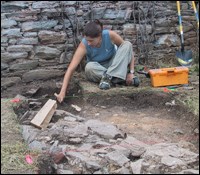
"Phase II" - Evaluation of Archeological Resources Archeological resources identified in Phase I investigations are evaluated during Phase II to determine if the resource is eligible for inclusion in the National Register of Historic Places. Larger units of exploration such as excavation units (EUs) are often utilized during Phase II field studies. When excavating an EU, archeologists use trowels or other small hand tools to remove soil within naturally-occurring soil layers or strata. Artifacts recovered from each soil strata are collected and analyzed separately. Changes in soil composition, color, and density signify a different soil strata, and are sometimes indicative of past human activities. Field notes, maps, and photographs are utilized to keep track of all the soil strata, artifacts, and other information for each EU. After field work is complete, the archeology team must analyze the recovered data to interpret the context, function, and time span of the site. This information is then used to determine the signficance of the site. Lastly, archeological researchers must prepare and complete a report detailing the project methodology, results, and recommendations. Learn more about Phase I methods ... |
Last updated: June 2, 2020
